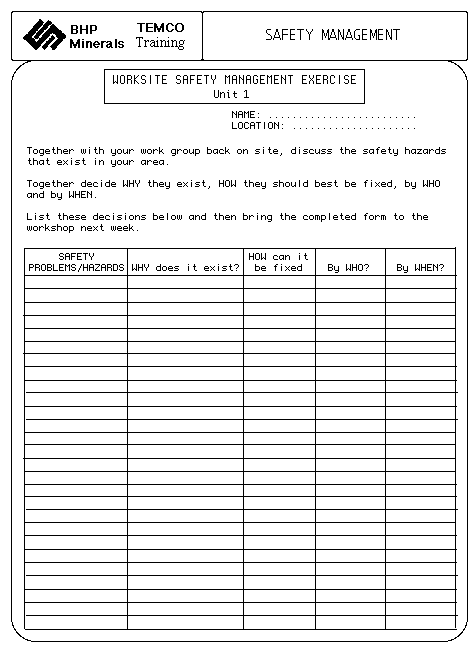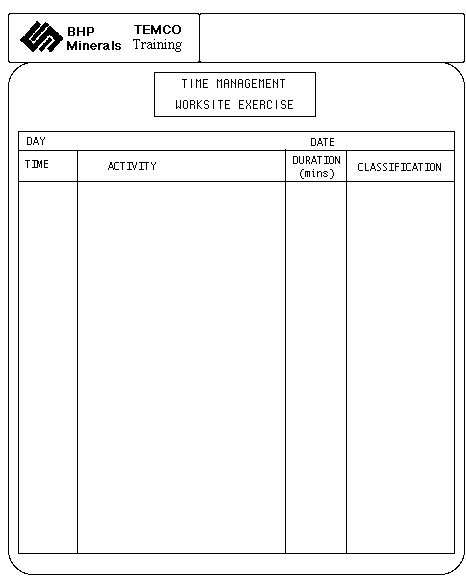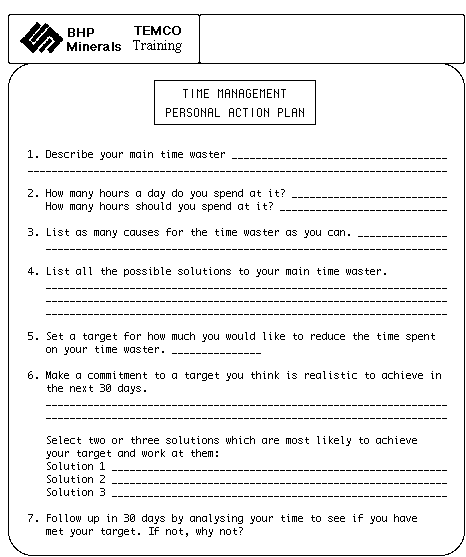
 |
Industry based training programs are characteristically discrete, intensive efforts conducted over one or more full days with limited practical application to the workplace. The clinical nature of classroom instruction depends upon the personal commitment of participants to retain and apply the knowledge and skills they have gained. Often, too, the culture of the environment, or simply the demands of the job works against any immediate or long term transfer of the "play" in the classroom to the reality on site.At BHP Temco (Tasmania), a producer of ferro alloys, learning design experiments with serialised classroom training and worksite exercises are providing more meaningful learning experiences for the participants. Spread across several weeks or months, time is designed into the program to allow participants to transfer learning to their own worksite with specially structured tasks or problems. The results of these exercises then form the basis for the next classroom session.
Participants are finding they are not overloaded with new knowledge or skills; they see the relevance and immediate application of instruction to their worksite; and are encouraged by the results that emerge from their own involvement and efforts.
Training and development in industry represents a major employer commitment that is steadily growing. Technical training, human relations training and management training all receive a large share of the multi billion dollar budget in an effort to improve products and services.
National and international markets are becoming more competitive, and the profitability of many businesses are being severely challenged. As accountability is being demanded and all budgets rationalised, value for the training dollar is also coming under close scrutiny. More than ever, training programs must demonstrate greater relevance and practical application to the workplace.
Put simply, what kind of training makes a difference to productivity?
Traditionally, training methods have been characterised by intensive efforts of classroom instruction, compressed into several days of continuous learning. Programs have often been served up in a packaged, off-the-shelf form or provided by breeze-in breeze-out consultants. One day seminars, three day workshops or five or ten day residential programs are common. Such activity usually provides a real adrenalin boost for the learners, gives some a welcome break from the routine of work but nevertheless is the most appropriate for certain topics or administrative needs.
Frequently though, discrete intensive programs represent an overload of information that is often too quickly discarded upon the return to the work place. Learners conform, perform and meet short term learning goals. The time frame of such programs restricts any opportunity for reflection on new/concepts sometimes called the gelatin effect - and limits any trialing of ideas or worthwhile testing of practical skills in the workplace. Too often the culture of the work environment, peer pressure or simply the demands of the job work against any immediate or long term transfer of the classroom "play" to the reality on site. Ultimately, the success of an intensive classroom program is dependent upon the personal commitment of participants to retain and apply the knowledge and skills they have gained.
By adopting a realistic pace for the program, the potential for information overload is eliminated, learning is maximised through appropriate incremental inputs and time is allowed for the classroom concepts to be applied to the practicalities of the work environment. Emphasis is placed on sequential and developmental learning and the outcome is an enhancement of the process and a greater return on the training dollar.
Classroom sessions that are scheduled, ideally for no more than four hours duration, allow sufficient time to introduce, develop and fully explore a session topic without belabouring the issue or wasting otherwise vital industry time. Learning a little and learning it well comes into play.
Regularly spacing classroom instruction on a weekly, fortnightly or monthly sequence - whatever is most desirable to the industry and participants - allows sufficient time to reflect on and internalise new concepts, test new processes and trial new skills in the place where industry training counts - the workplace. The practical application then subsequently provides the building block for the next classroom session.
The concept of serialised programming is well known in education and is becoming more accepted in industry. Without the need to conform to the time restrictions of a college semester, industry training programs can ultimately be designed specifically for the needs of the participants and the boundaries of the topic. Thus, a Time Management program may only need two sessions of four hours each, spaced one month apart to allow opportunity for the collection of data on each participant's personal use of time. A Safety Management program, incorporating safety hazards might best be designed with three or four sessions spaced one or two weeks apart to allow for adequate analysis of safety hazards on site, the generation of possible solutions for the removal of those hazards and the resting of a chosen solution.
Supervisory training for potential supervisors incorporates such a breadth and depth of new knowledge and skill that an ongoing regular program designed over six or even twelve months with regular field support could be desirable.
Ultimately, worksite tasks should apply concepts, processes or skills that were learnt in the preceding session or require the collection of work related data to provide the foundation for the following session topic. Examples of particular worksite exercises, used in industry are provided in Figures 1 to 3.


Obviously, detailed attention needs to be given to the design of a worksite exercise. It needs to be related to the preceding classroom learning and have significance and meaning for the individual in the workplace; it cannot be overly time consuming or it will be rejected outright; it must clearly form an integral part of the following classroom session so there is added incentive for completion; and if it involves group work, the group needs to be small and preferably from the same work unit so it can function as a learning project group.

Meaningful worksite action plans should incorporate the fundamental principles of any good goal setting:

The success of worksite action plans is dependent upon both the initial commitment of a participant to complete the personal plan, as well as the ongoing support and follow up from the participant's supervisor. To assist in this process, a copy of the completed action plan can be forwarded to the supervisor and supplemented with discussion by the training facilitator.

In the workplace, pressures and demands of work frequently take a higher priority than learning programs. The realities of the industry needs to be considered in the design of the serialised program, the scheduling of sessions and the planning and timing of worksite exercises.
Flexibility and contingency plans may be needed when session schedules are interrupted by unplanned events such as: industrial strikes, illness, annual leave commitments, personal workloads or preference for faster/slower learning cycles.
| Author: Judi Brown-Parker joined industry training in Tasmania after twenty years of learning, teaching and travel in Australia, Papua New Guinea, South East Asia and North America. From a position of Senior Lecturer in Physical Education and Health, she focused on administration, evaluation and teacher education. Together with her husband, she attended the University of Montana and then Michigan State University where she completed her PhD in Professional Development and Teacher Education. On returning to Australia she undertook a career change and is now employed by BHP Temco. She is also presently exploring another dimension of personal learning through the design and construction of the Australian dream in rural Tasmania.
Please cite as: Brown-Parker, J. (1988). Worksite exercises and serialised programs: Designing practical application into industry programs. In J. Steele and J. G. Hedberg (eds), Designing for Learning in Industry and Education, 69-76. Proceedings of EdTech'88. Canberra: AJET Publications. http://www.aset.org.au/confs/edtech88/brown-parker.html |